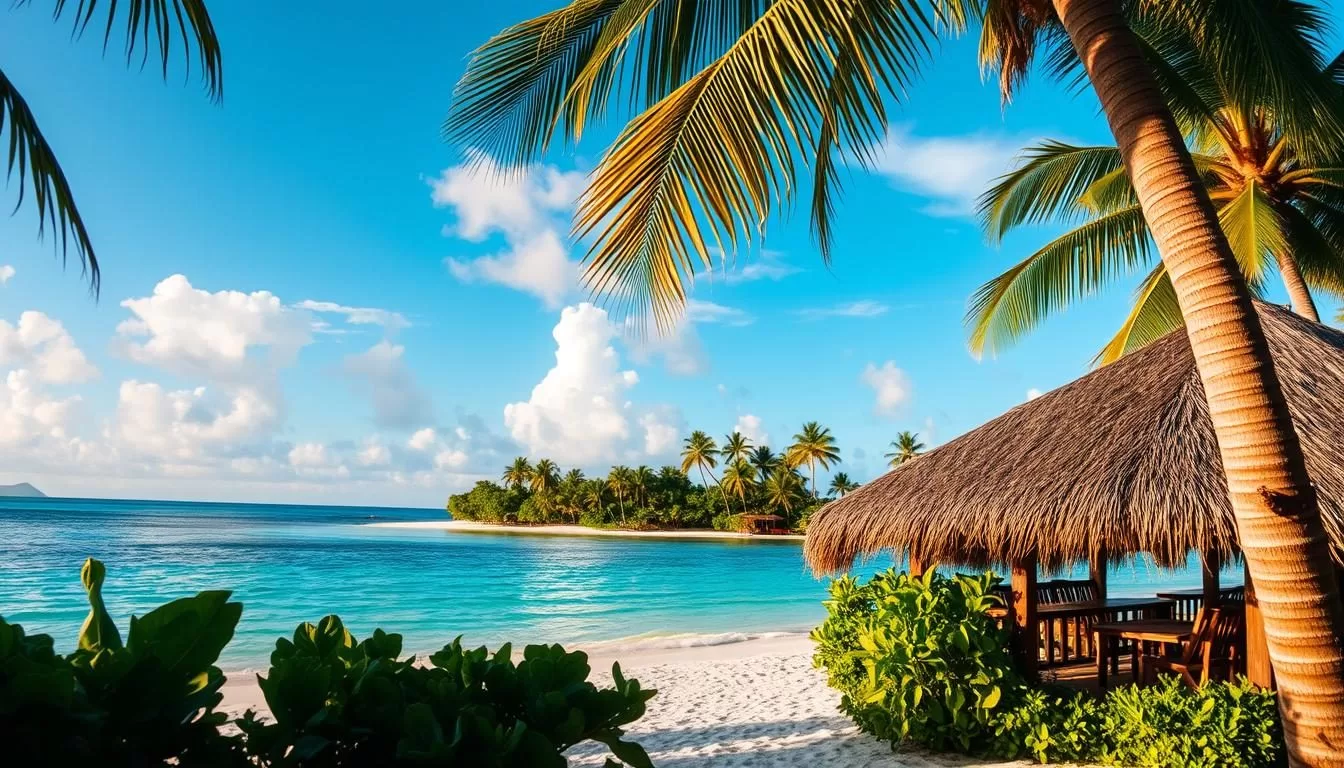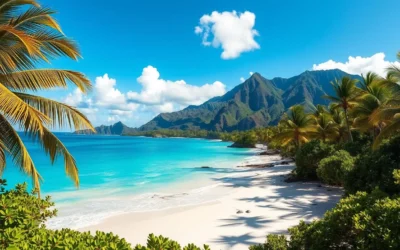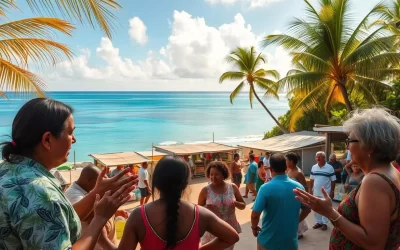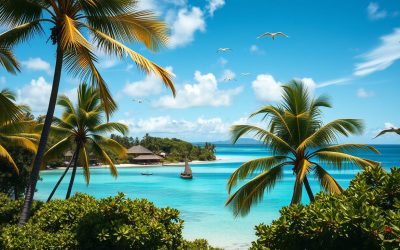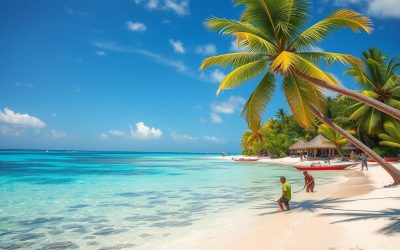✓ Accommodations✓ Flights✓ Rental Cars
You’re planning a trip to Kiribati, a stunning Pacific island nation known for its unique cultural experiences and breathtaking natural beauty. To make the most of your travel, understanding the distinct weather patterns that affect this equatorial paradise is crucial.
Kiribati’s tropical climate means warm temperatures year-round, but a unique phenomenon occurs in the central and eastern parts, where islands along the Equator receive a cool sea current from the east, arriving from South America. This makes the climate more arid and affects the best time to visit this beautiful destination.
As you prepare for your journey, this article will guide you through the different seasons in Kiribati, highlighting the ideal times for various activities and experiences based on weather conditions, ensuring a weather-savvy trip.
Understanding Kiribati’s Unique Climate
The climate in Kiribati is shaped by its equatorial location and other natural phenomena, creating a complex weather pattern. Located near the Equator, Kiribati’s islands are influenced by various climatic factors that make its weather distinct from other Pacific island nations.
Equatorial Location and Its Effects
Kiribati’s proximity to the Equator means it receives a relatively constant amount of solar radiation throughout the year. This consistent exposure contributes to the overall warmth of the islands. However, the equatorial location also subjects Kiribati to other climatic influences, such as trade winds and ocean currents, which play a significant role in shaping its climate.
The trade winds, for instance, bring warmth and moisture, contributing to the wet season in certain parts of the year. Understanding these factors is crucial for planning activities like snorkeling and diving, as they affect the waters around the islands.
The Cool Current Phenomenon
A unique aspect of Kiribati’s climate is the cool current that originates from South America and flows towards the islands. This phenomenon significantly impacts the climate, particularly in the central and eastern parts of Kiribati. The cool current makes the climate more arid than expected for an equatorial region.
This cool current also affects the marine ecosystem, creating a way for diverse marine life to thrive around the reef systems. During certain periods of the year, the conditions are ideal for snorkeling and diving, offering exceptional underwater experiences.
Dry Season vs. Wet Season in Kiribati
The weather in Kiribati is primarily divided into two seasons, each offering unique experiences. Understanding these seasons is key to making the most of your visit.
Dry Season: May to October
The dry season in Kiribati, spanning from May to October, is characterized by lower rainfall and more stable weather conditions. This period is considered ideal for outdoor activities such as snorkeling, diving, and exploring the islands. The dry season offers clear skies and calm seas, making it perfect for water-based adventures. With plenty of sunshine, visitors can enjoy the beautiful landscapes and vibrant culture without the hindrance of rain.
Wet Season: November to April
In contrast, the wet season from November to April brings increased rainfall and humidity. However, the rain often comes in short, heavy bursts rather than continuous downpours, allowing for activities between showers. Some benefits of visiting during the wet season include:
- Fewer tourists, making it a more secluded experience
- Lush, vibrant landscapes due to the increased rainfall
- Potentially lower prices for accommodations and tourist services
- A unique atmosphere with dramatic skies, ideal for photography
- Several hours of sunshine daily, allowing for planned activities around the weather
The wet season also hosts various cultural events and festivals, providing a rich cultural experience for visitors. If you’re considering the best time to visit Kiribati, weighing the pros and cons of each season is essential.
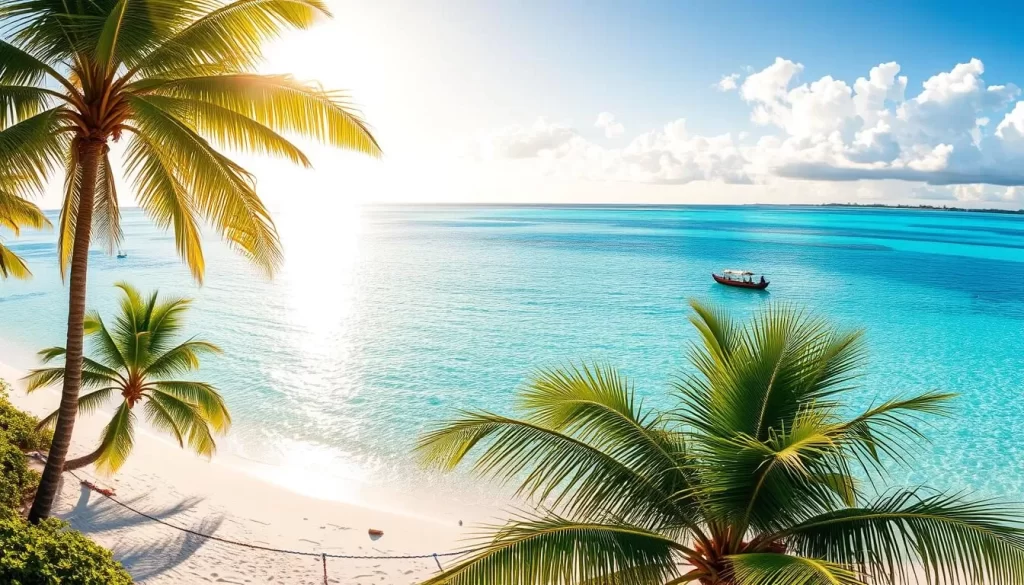
Kiribati: Best Months for a Weather-Savvy Trip
For travelers planning a trip to Kiribati, understanding the best months to visit is key. The islands offer a unique travel experience, with the weather playing a significant role in determining the quality of your trip. While the dry season is generally considered the best time to visit, it’s also important to consider the impact of tourist seasons on your travel experience.
Prime Months for Clear Skies and Calm Waters
The dry season, which runs from May to October, is characterized by clear skies and calm waters, making it the prime time for water-based activities like snorkeling and diving. During this period, the weather is generally dry and sunny, with minimal rainfall. The calm seas and clear visibility make it an ideal time for exploring the underwater world of Kiribati.
The shoulder months of May and October are particularly noteworthy as they offer a great balance between good weather and fewer tourists. If you’re looking for a more secluded experience, considering these months can be a good way to enjoy the islands without the peak season crowds.
Balancing Weather with Tourist Crowds
While the dry season offers the best weather, it can also bring more tourists to Kiribati. However, the islands remain relatively uncrowded compared to many other Pacific island destinations due to their remote location. Finding the right balance between optimal weather and avoiding crowds is an important consideration when planning your trip to these islands.
To achieve this balance, consider visiting during the shoulder months or the early dry season. This can provide you with a more relaxed experience, allowing you to enjoy the natural beauty of Kiribati without the hustle and bustle of peak tourist season. Planning your trip at the right time can make a significant difference in your overall experience.
By understanding the ebb and flow of visitors to this unique destination, you can plan a trip that aligns with your preferences for either social interaction or peaceful seclusion, making your travel experience truly unforgettable.
Planning Your Visit in the Dry Season
As you plan your trip to Kiribati, understanding the dry season can significantly enhance your travel experience. The dry season, which spans from May to October, is characterized by favorable weather conditions that make it an ideal time to explore the islands.
May-June: Beginning of Ideal Weather
The months of May and June mark the beginning of the dry season in Kiribati, offering a great opportunity to enjoy the country’s beautiful landscapes and waters. During this time, you can expect minimal rainfall and pleasant temperatures, making it perfect for outdoor activities. Some of the key benefits of visiting during May and June include:
- Comfortable weather for exploring the outer islands
- Ideal conditions for water-based activities like snorkeling and diving
- Less crowded tourist spots compared to the peak months
July-October: Peak Dry Season Experience
The period from July to October is considered the peak of the dry season in Kiribati. 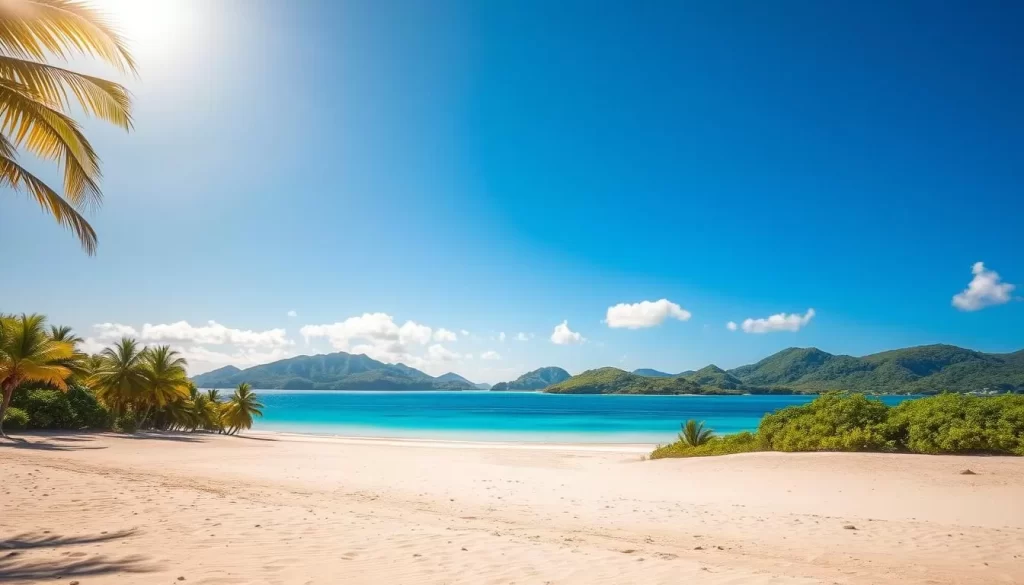 This time offers the most reliable weather conditions, making it perfect for exploring even the most remote islands. You can enjoy:
This time offers the most reliable weather conditions, making it perfect for exploring even the most remote islands. You can enjoy:
- Consistent weather patterns, allowing for confident planning of activities
- Excellent visibility for snorkeling and diving in the coral reefs
- Comfortable land exploration due to reduced rainfall
- Reliable inter-island transportation
Visiting Kiribati during the peak dry season ensures that you have a smooth and enjoyable trip, with optimal conditions for various activities and travel between islands.
Visiting During the Wet Season: What to Expect
Despite the rain, visiting Kiribati during the wet season has its advantages, including a more authentic glimpse into local life. The wet season, which runs from November to April, brings significant changes to the islands, transforming them into lush landscapes with fewer tourists.
Transition Period
November and December mark a transition period, where the dry season’s warmth gradually gives way to the wet season’s rainfall and humidity. During this time, you can experience the unique blend of weather conditions, making it essential to be prepared for variable weather.
Managing Rainfall and Humidity
From January through April, Kiribati is in the heart of the wet season, with increased rainfall and humidity. To make the most of your visit, it’s crucial to take precautions against the rain and maintain good health practices. This includes being prepared for short, intense rain bursts and taking measures to protect your belongings from moisture.
- Be flexible with your plans, allowing for adjustments based on daily weather conditions.
- Schedule indoor activities on particularly rainy days.
- Maintain good health practices, being mindful of the increased risk of mosquito-borne diseases in some areas of the country.
- Protect your electronic equipment and important documents from moisture damage.
- Enjoy the lush landscapes, fewer tourists, and a more authentic experience.
By being prepared and flexible, you can have a rewarding experience in Kiribati during the wet season, enjoying the unique aspects of travel during this time.
Island-Specific Weather Considerations
As you plan your trip to Kiribati, it’s crucial to consider the unique weather conditions of the different islands. Kiribati is an archipelago with diverse weather patterns across its islands, which can significantly impact your travel experience.
Tarawa and the Gilbert Islands
Tarawa, being part of the Gilbert Islands, experiences a tropical climate with high temperatures throughout the year. The wet season, from November to April, brings significant rainfall, while the dry season, from May to October, is characterized by clearer skies and calmer seas. When visiting Tarawa and the Gilbert Islands, you should be prepared for the prevailing weather conditions to make the most of your trip.
- The wet season can bring occasional heavy downpours, so it’s wise to pack accordingly.
- During the dry season, the pleasant weather makes it ideal for outdoor activities such as snorkeling and exploring the islands.
Christmas Island and the Line Islands
Christmas Island (Kiritimati) and the Line Islands have a distinctly different climate compared to the Gilbert Islands. These outer islands tend to be drier overall, influenced by the cool current phenomenon that affects the central and eastern parts of Kiribati. The drier climate of Christmas Island makes it particularly appealing for activities such as bird watching and exploring the extensive reef systems.
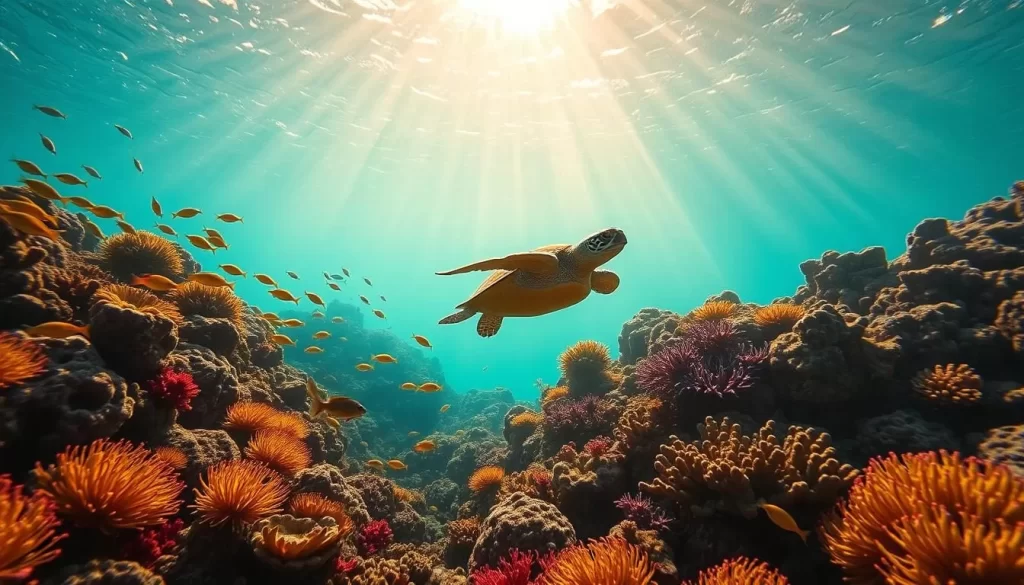
When planning a multi-island itinerary, you should account for these regional differences to ensure you pack appropriately for each destination. The unique climate of the Line Islands has shaped both the natural environment and human activities in these areas, creating distinctive ecosystems and cultural practices worth experiencing.
- The drier conditions make the Line Islands an attractive destination for those looking to explore diverse ecosystems.
- Understanding the local climate helps in appreciating the cultural practices and natural beauty of these islands.
Outdoor Activities Based on Weather Conditions
Outdoor enthusiasts visiting Kiribati can choose from a variety of activities tailored to the prevailing weather conditions. The islands offer a mix of water-based adventures and land exploration opportunities, ensuring that there’s something for every kind of traveler.
Water-Based Adventures: Snorkeling and Diving
Kiribati is renowned for its exceptional snorkeling and diving experiences, with numerous sites that showcase the islands’ rich marine biodiversity. The clear waters and coral reefs provide a perfect setting for exploring the underwater world.
The dry season, from May to October, is considered ideal for snorkeling and diving due to the calm seas and excellent visibility. During this period, you can witness an array of marine life, including sea turtles and colorful fish species.
Land Exploration and Cultural Experiences
Exploring Kiribati’s islands on foot offers insights into local life and culture that can’t be gained any other way. You’ll discover that land-based activities are possible year-round, though the dry season offers more comfortable conditions with drier paths and fewer interruptions from rain showers.
- Cultural experiences, including village visits and traditional performances, provide authentic connections with the I-Kiribati people and their unique way of life.
- Historical sites across the islands tell fascinating stories of Kiribati’s past, from ancient settlements to World War II battlefields that shaped the nation’s history.
- When planning your travel itinerary, balance water and land activities to get a complete picture of what makes these islands special.
Health and Safety Considerations by Season
Understanding the seasonal health and safety considerations is vital for a safe and enjoyable trip to Kiribati. The tropical climate poses specific risks that vary between the dry and wet seasons.
Mosquito-Borne Diseases and Prevention
During the wet season, the risk of mosquito-borne diseases such as dengue fever increases. To minimize this risk, it’s essential to take precautions against mosquito bites.
- Use insect repellent containing DEET, picaridin, or oil of lemon eucalyptus on exposed skin.
- Wear long-sleeved shirts, long pants, and socks when outdoors.
- Stay in accommodations with screened windows and doors.
Sun Protection and Heat-Related Precautions
Kiribati’s equatorial location means intense sun exposure year-round. Visitors should use high-SPF sunscreen, wear hats and sunglasses, and stay hydrated to prevent sunburn and heat-related illnesses.
- Applying high-SPF sunscreen regularly and reapplying after swimming or sweating.
- Seeking shade during the peak sun hours of 10 AM to 4 PM.
- Drinking plenty of water to stay hydrated and moderating your activity level during the hottest parts of the day.
By taking these health and safety precautions, you can minimize the risks associated with Kiribati’s climate and enjoy your trip. Watch for early signs of heat-related illness, including headache, dizziness, and excessive sweating, which could progress to more serious conditions like heat stroke if not addressed.
Packing Essentials for Different Seasons
To make the most of your trip to Kiribati, it’s essential to pack according to the season you’re traveling in. The country’s climate varies significantly between the dry and wet seasons, and being prepared is key to a comfortable and enjoyable journey.
Dry Season Packing List
During the dry season, which spans from May to October, you can expect plenty of sunshine and dry conditions. It’s ideal to pack:
- Lightweight, breathable clothing to keep you cool in the tropical heat.
- Sun protection, including sunscreen, a hat, and sunglasses.
- Comfortable walking shoes or sandals for exploring the islands.
These essentials will help you enjoy the clear skies and calm waters that Kiribati is known for during this period.
Wet Season Packing List
For the wet season, from November to April, you’ll need to add a few more items to your packing list. In addition to the dry season essentials, consider bringing:
- A high-quality, breathable rain jacket to keep you dry.
- Quick-dry clothing that won’t stay damp in the humid conditions.
- Waterproof bags or cases for your electronics, important documents, and other items that need to stay dry.
- Extra insect repellent with DEET to protect against mosquito bites, particularly during dawn and dusk.
- A portable mosquito net if your accommodations don’t provide one, to safeguard against dengue fever.
It’s also a good idea to include basic medications in your travel health kit, such as fever reducers and oral rehydration salts, as access to pharmacies may be limited, especially on outer islands.
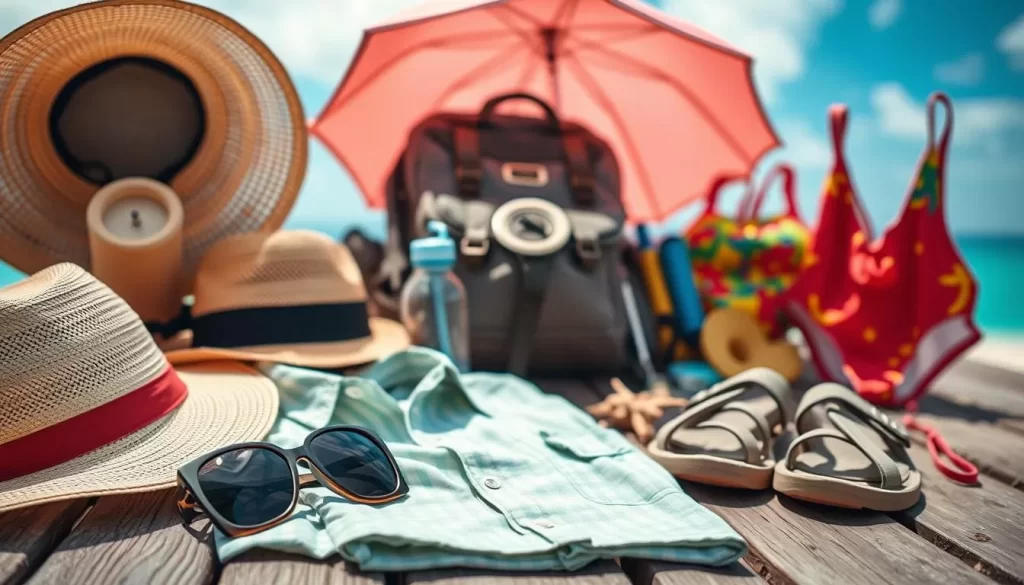
Accommodation Options Throughout the Year
Kiribati offers a range of accommodations to suit different preferences and budgets throughout the year. Whether you’re visiting during the peak season or the off-season, you’ll find suitable options to make your stay comfortable and enjoyable.
Where to Stay During Peak Season
During the peak season, which typically falls within the dry season from May to October, Kiribati’s popular destinations are bustling with tourists. You can expect to find a variety of accommodations, from luxury resorts to budget-friendly guesthouses, particularly on Tarawa and Christmas Island. The tourist infrastructure is fully operational, offering a range of services and activities. If you’re looking for the best hotels in Kiribati, consider booking in advance to secure your preferred choice.
Off-Season Accommodation Benefits
Visiting Kiribati during the off-season or shoulder seasons can offer several benefits, including better availability and potentially lower rates at accommodations. Some of the advantages of staying during this time include:
- Better availability and more flexibility with your travel dates
- Potentially lower rates and more negotiating room for longer-term stays
- More personalized service and attention from staff at tourist facilities
- A more authentic experience and greater opportunities to connect with local communities
- Full operational capacity is not always guaranteed on Christmas Island or other outer islands, so it’s advisable to confirm availability in advance.
By considering an off-season visit, you can enjoy a more relaxed and potentially cost-effective trip to Kiribati.
Transportation Considerations by Season
As you plan your trip to Kiribati, consider how the different seasons affect transportation options. The country’s transportation network is heavily influenced by its seasonal weather patterns, making it essential to understand these variations for a smooth journey.
Inter-Island Travel Weather Dependencies
Inter-island travel in Kiribati is often weather-dependent, with certain periods being more favorable than others. During the dry season, traveling between islands is generally easier, with more reliable boat schedules and fewer disruptions.
In contrast, the wet season can make inter-island travel more challenging due to rough seas and increased rainfall. You should be prepared for potential delays or changes in travel plans.
Road Conditions During Different Seasons
Road conditions in Kiribati vary significantly by season, particularly in rural areas where roads are often unpaved. During the wet season, these roads can become muddy and difficult to navigate.
Road Conditions by Season
| Season | Road Conditions | Travel Tips |
|---|---|---|
| Dry Season | Generally good, with dry and stable roads | Traveling is relatively easy, with fewer disruptions |
| Wet Season | Muddy and potentially impassable, especially in rural areas | Be prepared for challenging road conditions and potential delays |
Even in South Tarawa, where the main road is paved, heavy rains can cause temporary flooding, affecting transportation. Local driving practices may seem chaotic to visitors, with limited adherence to traffic regulations and varying vehicle conditions. For safety reasons, it’s advisable to avoid driving at night, particularly during the wet season when road visibility can be poor.
Consider arranging transportation through your accommodations when possible, as they can recommend reliable drivers familiar with local road conditions and safe practices in the country. This can help ensure a safe and smooth journey throughout Kiribati.
Cultural Events and Festivals by Season
Kiribati’s cultural events and festivals are an integral part of the island’s identity and daily life. The island nation celebrates various occasions throughout the year, providing a unique insight into the local way of life and traditions.
Traditional Celebrations and Their Timing
Kiribati’s cultural calendar is rich with traditional celebrations, each with its own significance. These events are often tied to the changing of the seasons or important dates in the local calendar. For instance, certain festivities may coincide with the dry season, while others may take place during the wet season. Understanding the timing of these events can help you plan your visit to coincide with these unique experiences.
Participating in Local Festivities
Visitors to Kiribati are often welcomed to participate in local festivities, offering a meaningful way to connect with the culture and traditions of the islands. When attending these events, it’s essential to dress modestly and respect local customs. By doing so, you can enjoy a more immersive experience and gain a deeper understanding of the I-Kiribati people’s daily life and cultural practices.
Learning a few basic phrases in the local language can also enhance your experience, showing respect for the cultural heritage of the communities you visit. By participating in these events, you can gain unique insights into the social structures and daily life that you wouldn’t experience through typical tourist activities.
Conclusion
Planning a trip to Kiribati requires insight into its climate to maximize your travel experience. As you’ve learned, the best time to visit Kiribati largely depends on your preferences and the experiences you’re seeking.
The dry season, from May to October, generally offers the most reliable weather for outdoor activities and island exploration, making it the best time to visit for most travelers. If you’re looking for a more authentic experience with fewer tourists, the wet season might be more appealing, despite the occasional rain showers.
Regardless of when you choose to travel to this unique destination, proper preparation is key. Understanding Kiribati’s climate patterns, packing accordingly, and planning flexible itineraries will ensure a rewarding experience. Kiribati, as a destination, offers extraordinary natural beauty, warm hospitality, and cultural experiences that remain relatively untouched by mass tourism.
By being weather-savvy and planning accordingly, you’ll be able to fully immerse yourself in the beauty and culture of Kiribati. Whether you’re drawn to the clear skies of the dry season or the lush landscapes of the wet season, Kiribati promises a truly special experience for those willing to venture off the beaten path.
As you embark on your trip, remember that the essence of Kiribati lies not just in its climate, but in its rich culture and stunning environments. With the right preparation and timing, your visit will be a memorable one.
The above is subject to change.
Check back often to TRAVEL.COM for the latest travel tips and deals.
